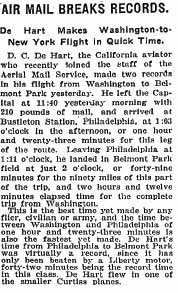January 4, 1919 – Belmont Park, New York
During his months as an airmail pilot, California-born Dana C. DeHart had the service's best record with 191 trips, only 7 forced landings, and 5 uncompleted trips. Like many of the other pilots, DeHart came to the service from the Army. He joined the service only a few days after the Post Office Department had taken control of it. On May 15, 1919, the New York Times reported that DeHart had flown 101 legs of the New York – Washington route, covering a distance of 21,300 miles.
Later that year, the New York Times congratulated DeHart on breaking a speed record, flying from New York to Washington in just two hours and 12 minutes.
AIR MAIL BREAKS RECORDS.
De Hart Makes Washington-to-New York Flight in Quick Time
D. C. De Hart, the California aviator who recently joined the staff of the Aerial Mail Service, made two records in his flight from Washington to Belmont Park yesterday. He left the Capital at 11:40 yesterday morning with 210 pounds of mail, and arrived at Bustleton Station, Philadelphia, at 1:03 o'clock in the afternoon, or one hour and twenty-three minutes for this leg of the route. Leaving Philadelphia at 1:11 o'clock, he landed in Belmont Park field at just 2 o'clock, or forty-nine minutes for the ninety miles of this part of the trip, and two hours and twelve minutes elapsed time for the complete trip from Washington.

Learn more »
This is the best time yet made by any flier, civilian or army, and the time between Washington and Philadelphia of one hour and twenty-three minutes is also the fastest yet made. De Hart's time from Philadelphia to Belmont Park was virtually a record, since it has only been beaten by a Liberty motor, forty-two minutes being the record time in this class. De Hart flew in one of the smaller Curtiss airplanes.
DeHart died in San Mateo, California on July 16, 1975 at age 89.


On February 25, 1919, DeHart sent this letter from the Belmont Park, New York airmail field to Superintendent Egge of the Air Mail Service. In his letter, DeHart advises Egge that the newly reconstructed de Havilland (known as the twin de Havilland) would not be successful mail aircraft. DeHart was proven right when the twin de Havillands performed miserably.
Learn more about Twin de Havilland airplanes.